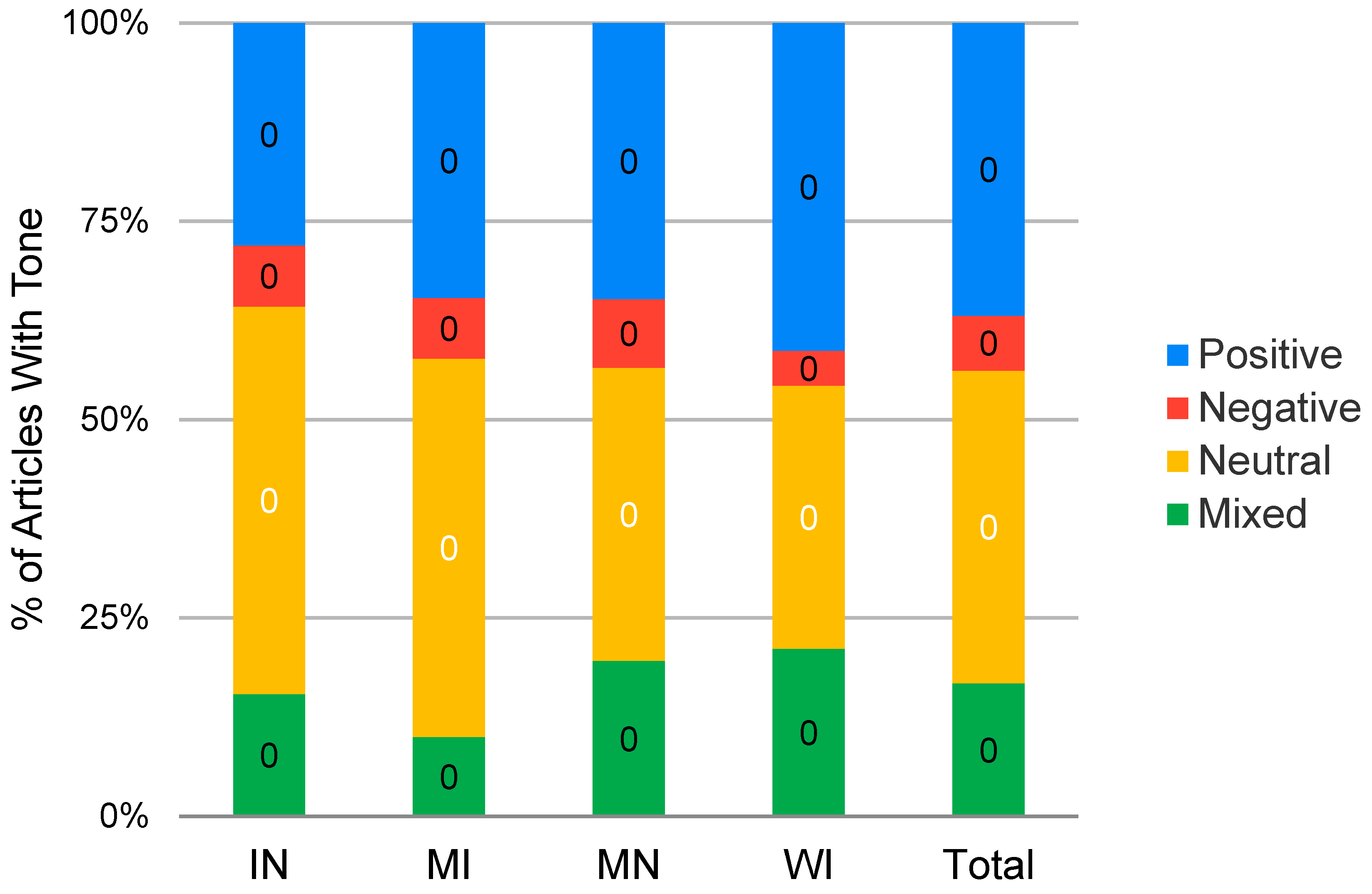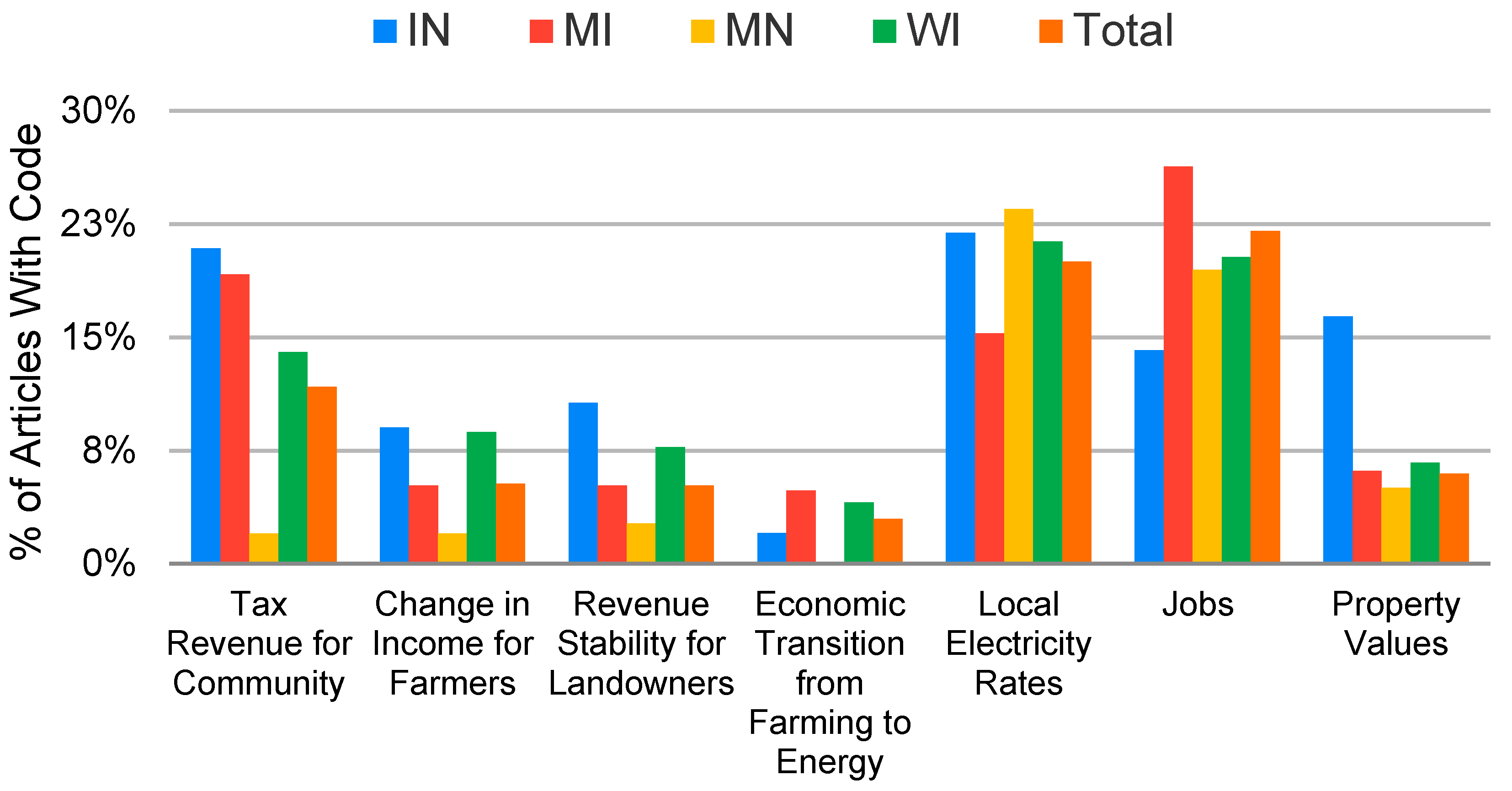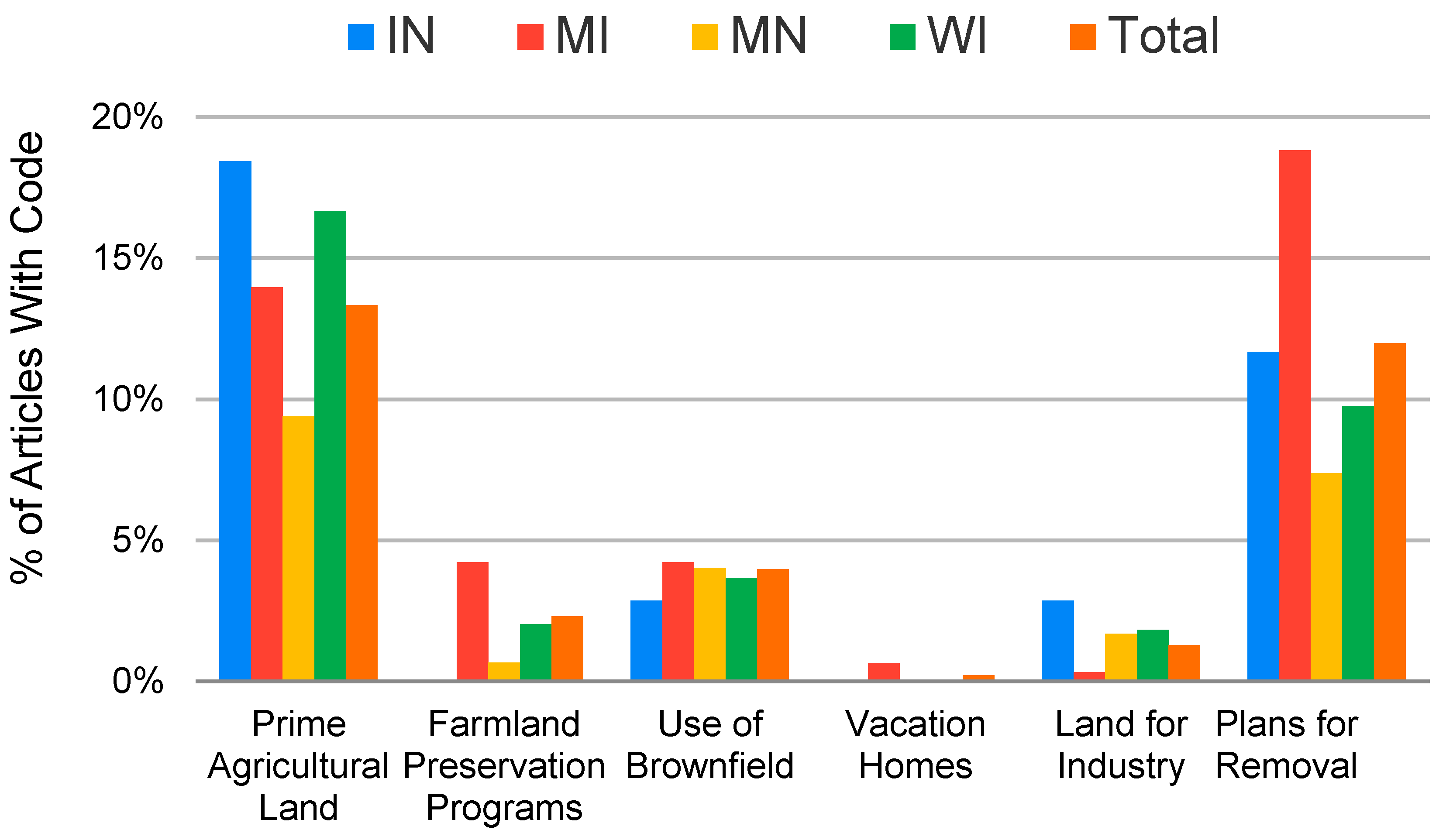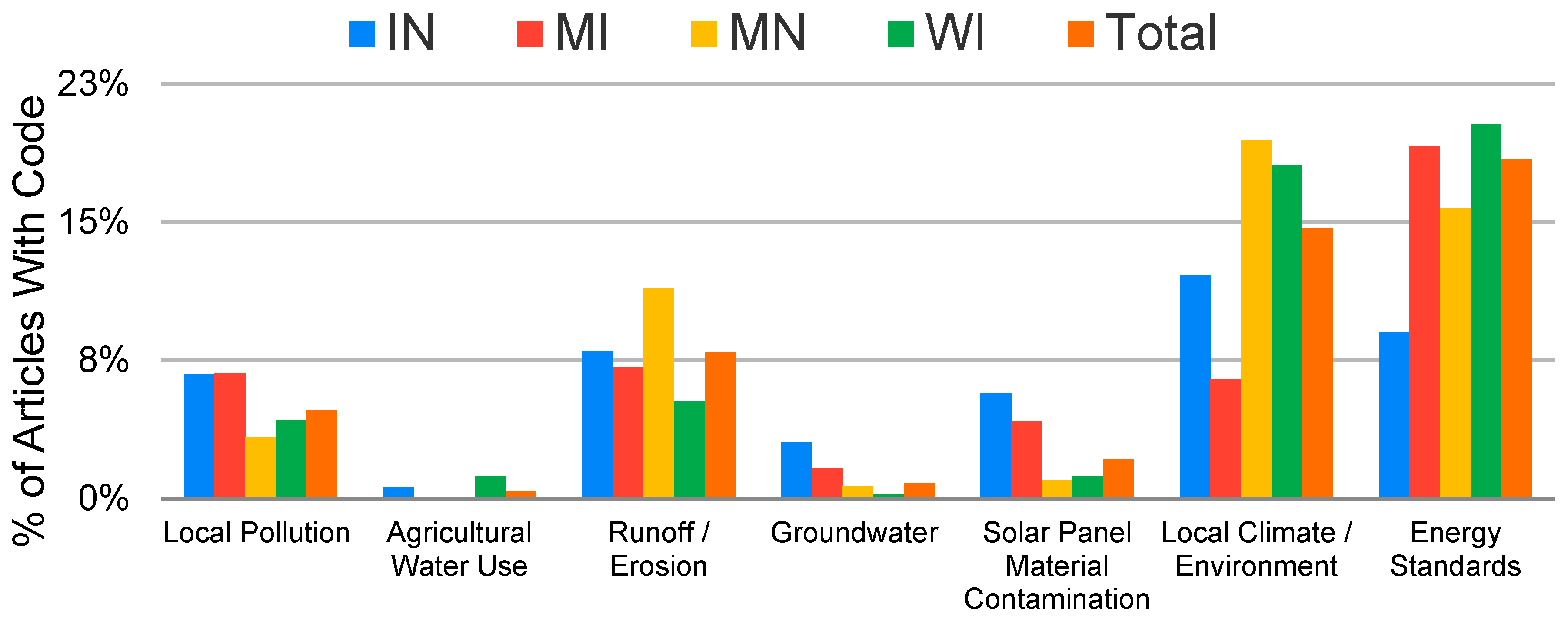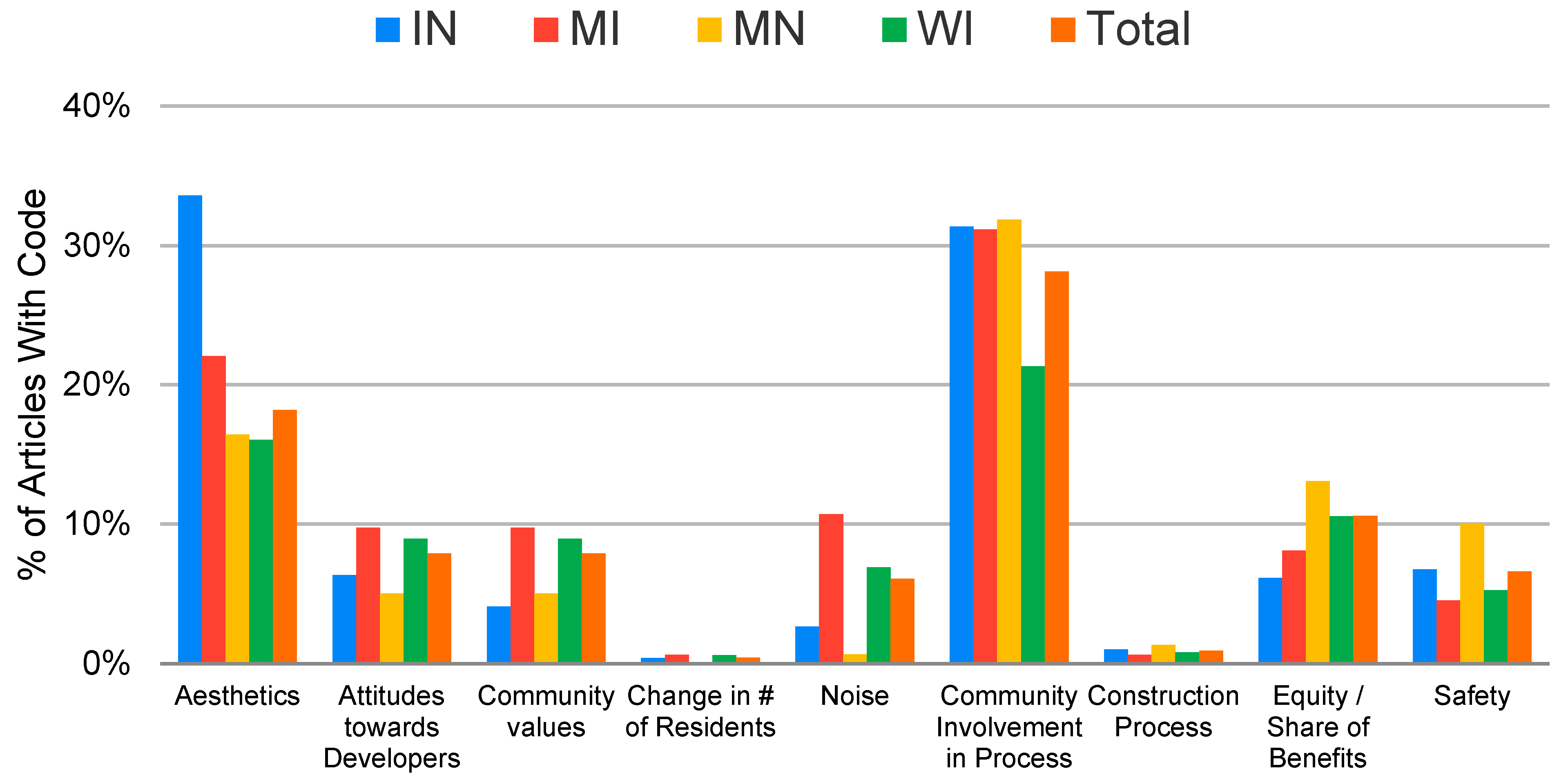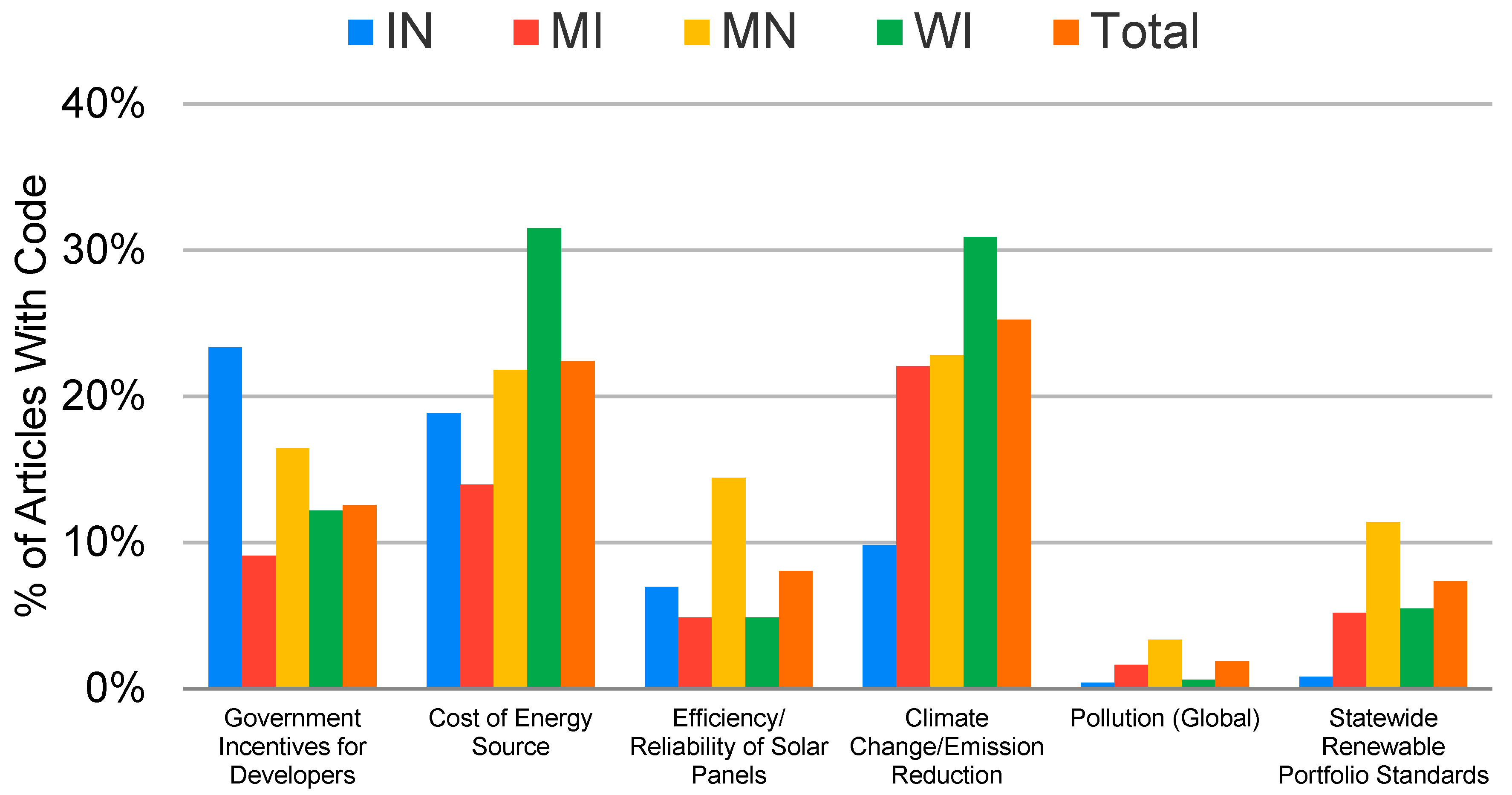1. Introduction
In recent years, scientific consensus has made two things clear: human emissions are both causing rising global temperatures and must be drastically reduced in order to mitigate the worst effects of a rapidly changing global climate [
1]. Currently, experts estimate that 27 percent of all United States greenhouse gas emissions originate from electricity production processes [
2]. However, fossil fuel emission is no longer a necessary aspect of electricity production. In recent years, improvements in renewable energy technology have increased the efficiency and cost of many renewable energy systems, including solar facilities. Now, solar power is cheaper than coal and natural gas in many parts of the country, even without government subsidies [
3]. As a result, market forces and a concern for emissions reductions have aligned, and they are both pushing for a transition to solar power in communities. While solar power can be a practical choice on a small-scale, individualized level with rooftop installations, utility-scale solar projects bring renewable energy to the grid on a larger, more cost-effective scale [
4]. However, not every community is embracing opportunities to have utility-scale solar projects in their backyard. Opponents have raised many concerns, ranging from frustration over the loss of the natural beauty of their area to worries that installations on farmland could threaten their local economy and food production [
5]. Meanwhile, supporters have framed these utility-scale projects as win–win solutions that help the environment and provide economic opportunities to their communities [
6]. However, as several past studies emphasize, utility-scale solar facilities are large developments that have strong potential to make both positive and negative impacts on their hosts [
7,
8,
9,
10]. In addition to their wide-ranging effects on biodiversity, land conservation and water use, utility-scale solar facilities may also have social impacts on their host communities. As solar developments push communities to transition from traditional agricultural towns and economies to energy production centers, many questions are raised about the impact that these facilities will have on the jobs, livelihoods and traditions of community members. As past studies have shown, strong community support is a key component in any successful implementation of an energy project [
11]. Therefore, as the need for renewable energy resources continues to rise, it is important to understand how potential solar communities are answering these vital questions about the environmental and social impacts of solar.
In recent years, the Great Lakes states have become a new epicenter of utility-scale solar developments. Though the Midwest has typically lagged behind the rest of the United States in renewable energy development, changes in state renewable energy goals and improvements in solar panel technology have made solar an attractive option for the region [
12]. According to the United States Energy Information Administration’s dataset on all existing and new power generation facilities, the 120 GW of proposed solar projects in the four Midwest states addressed by this paper (i.e., Indiana, Michigan, Minnesota, and Wisconsin) would more than double the existing 114 GW already in operation [
13]. Furthermore, the size and scale of solar projects in the region are quickly increasing, with existing solar energy facilities in these states averaging 20.7 MW, compared to 77.8 MW for proposed facilities [
13]. The Great Lakes states are clearly in the midst of a solar energy boom.
But how is this boom perceived among the communities being asked to host these projects? Are these projects seen as an opportunity for participating in cleaning what has been a largely coal-dominated grid or, alternatively, as a threat to existing energy-sector jobs? While the Midwest’s vast tracts of farmland present cost-effective sites for hosting solar panels, to communities with agriculturally based economies, these developments may be seen as just another productive use of the landscape and way to diversify farm incomes or as a threat to farming and farm landscapes [
14]. By analyzing local newspaper articles for community reactions to large solar projects throughout four states in the Great Lakes region, this research considers the factors that influence community support and opposition for utility-scale solar energy projects in order to build a greater understanding of this debate.
2. Literature Review
The public’s attitude towards any given energy technology is a crucial component in its adoption and deployment. Of all the renewable energy sources, solar power tends to have the most support from the public [
11,
15,
16,
17]. A large majority of Americans want an increased reliance on renewables such as solar and wind power [
16]. Americans also strongly support the development of utility-scale solar energy, or USSE, as people perceive solar power as cleaner, fairer, and more just than other energy sources [
18,
19]. However, local attitudes towards USSE developments do not always match overall public support of solar power.
While solar power has strong support from the general population, studies have shown that individuals often react differently when presented with a proposed development in their area. According to van der Horst [
20], individuals who are very supportive of renewable energy tend to support projects proposed in their area while individuals who are opposed tend to remain opposed. However, the individuals who are only weakly supportive of renewables usually end up opposing local projects [
20]. This phenomenon is referred to as NIMBYism. NIMBY, or Not In My Backyard, is defined by Dear [
21] as “the protectionist attitudes of and oppositional tactics adopted by community groups facing an unwelcome development in their neighborhood” [
21] (p. 288). A case study from Portugal found that, of all the renewable energy sources, solar power received the weakest NIMBY response from residents [
15]. Despite this, NIMBYism can still impact local attitudes towards large USSE projects coming to their communities. These NIMBY responses are typically dependent on how visible and audible the proposed solar project is for a resident [
20]. The noise and visual impacts can usually be mitigated with a buffer distance. In a case study from California, individuals preferred a buffer distance of one to five miles between a USSE development and residential areas [
18]. Carlisle et al. [
18] proposes that these buffer distances should be regarded as proxies for solar development opposition, where any projects that encroach on one to five miles should anticipate some local pushback.
However, NIMBYism is not the only factor that influences community support of new USSE developments. Beyond proximity, support for USSE projects is also dependent on other facility characteristics, such as size or scope of the development [
18]. Additionally, studies have found that the level of transparency and involvement of local stakeholders during development can have significant impacts on community support [
22]. Usually, local stakeholders oppose USSE developments when they do not see substantial public participation in the planning and development processes [
8]. Attitudes towards USSE developments have also been known to shift throughout the stages of development [
23,
24]. Typically, projects receive the most opposition at their proposal stage and then the opposition fades after the project has been completed [
18]. Once opposition fades after a project is complete, perceptions can shift towards acceptance for future projects. When an individual already lives in proximity to a renewable energy project, they are often much more willing to accept another development within their community [
25]. All of these findings demonstrate that community support cannot be simplified into one measure of proximity to a proposed solar development. Opposition to USSE projects can change based on the scope, stage, experience with and the perceived equity of a development.
Additionally, many residents cite their concern for the aesthetic of their area as the motivating factor for their opposition to nearby USSE developments. Many studies in the US Southwest, where land and sun for solar developments is abundant, have noted concerns that USSE projects will damage the natural beauty of the region, especially its national parks, wilderness areas, and trails [
8,
24,
26]. Although PV modules or mirrors are placed low to the ground, many communities also worry about glare from their highly reflective surfaces that can reach miles from the site [
26]. Additionally, communities may dislike the fact that solar energy developments require a large amount of land per unit of energy produced [
26]. However, the impact of the visibility of a project on its community support is not uniform throughout every community. Individuals who live in stigmatized areas are typically more supportive of green developments [
20]. In opposition, individuals who gain a sense of identity from their landscape or rely on the beauty of their local environment to support their economy are typically less supportive of green developments [
20,
27]. For example, support for a USSE development in California called Ivanpah was directly linked to the value that different groups placed on the land in question. Developers of the project argued that Ivanpah’s proximity to a highway and Las Vegas made the visual and environmental impacts of the project inconsequential [
28]. However, opponents argued that the site was on a biodiverse old growth desert habitat. Local Native American tribes protested the siting because it was within view of a sacred prayer site [
28]. In the opponents’ view, the land was more valuable than the developers made it out to be. Ultimately, the project moved forward, but Ivanpah still represents the tradeoff that plagues so many USSE developments: local habitat degradation vs. global climate mitigation.
Environmental concerns can lead to both local support and opposition of proposed USSE developments. On one hand, USSE developments prevent large amounts of carbon dioxide from being released into the atmosphere and help to mitigate against the dangerous effects of global climate change. One study estimates that a 50 MW parabolic trough can keep 80,000 tons of carbon dioxide out of the atmosphere every year [
29]. On the other hand, USSE disrupts local habitats and can negatively impact carbon sequestration from vegetation removal [
9]. Abbasi and Abbasi [
7] argue that this issue is not so nuanced and claim that, “renewable energy sources are not the panacea they are popularly perceived to be; indeed in some cases their adverse environmental impacts can be as strongly negative as the impacts of conventional energy sources” (p. 121). These concerns are largely attributed to local habitat degradation. Conservationists have been very vocal about opposition to USSE developments in the desert Southwest, particularly at Ivanpah. Many studies present the direct impacts of USSE on local habitats [
8,
9,
29,
30,
31], but quantifying these impacts is an area that requires additional research. Despite these existing uncertainties, both concern for the global climate and concern for local habitats are regularly cited as motivating factors in an individual’s readiness to support USSE projects in their community.
Finally, studies have found that support for USSE is often driven by economic impacts. Generally, solar power has such high levels of support nationally because it is a very cheap way to produce energy. Solar energy systems have become much more affordable in recent years, and utility-scale systems enjoy economies of scale which further lowers the cost of the energy that they produce [
32]. However, one economic drawback to USSE is the high cost of land. Solar energy produces approximately 200 W per 1 square meter of land, so large amounts of land are required to build USSE developments [
29]. When farmers rent out their land for USSE development, they gain supplemental income. Compensation for a project typically translates to project acceptance from the farmer and even from the surrounding community [
33]. In addition to these aspects, there are a variety of other economic impacts, such as the effect of tax revenue and changing community economic conditions on residential support, to be explored.
Navigating national–local solar acceptance gaps can be difficult. Many variables, from proximity to local economic impacts, can change the perception, and ultimately acceptance, of proposed USSE developments. No one factor seems to influence communities more than the rest, and even factors that appear to be simple, such as NIMBYism, have complex nuances [
18]. Previous studies have shown that, theoretically, communities would be most receptive to a USSE project that has a large buffer zone, is smaller in scale, and includes considerations for local residents in the development process. Additionally, communities are more likely to support developments that are not placed on highly valued land or perceived to have a negative impact on the local environment or economy. It is clear that community support for USSE developments is nuanced and complicated. If USSE projects are going to be part of our efforts to mitigate climate change, it will be important to have a strong understanding of these complexities, so that USSE projects can be distributed in the most equitable and successful manner.
While previous research on community reactions exists, much of it is based in the Southwest and focuses on solar developments in open, undeveloped areas. In the Midwest, USSE projects are being proposed and developed on farmland which raises additional concerns from local communities. One study by Bessette and DePew [
34] analyzed a sample of town hall meetings and newspaper articles related to community reactions to both wind farm and USSE developments throughout the state of Michigan. Similarly to other studies, Bessette and DePew [
34] found that residents who were concerned about the development of a USSE project in their communities in Michigan were often focused on the lack of consideration for the community in the development process and the effect the USSE project would have on the aesthetics of their area. However, additionally, many community members raised new concerns about the impact a USSE project would have on their local agricultural production and economy. In order to better understand this concern and other aspects of local support for USSE developments throughout the Midwest, this study hopes to build upon Bessette and DePew’s work through a wider reaching content analysis of newspaper articles written about USSE projects in four Midwestern states since the end of 2018, a time period with significant expansion of utility-scale solar developments in the region [
13]. Through this work, this study ultimately hopes to answer the following question: what factors most contribute to community support and opposition for USSE developments throughout the Midwest?
3. Materials and Methods
In order to learn what the most common community reactions were to utility-scale solar energy projects in Michigan, Wisconsin, Minnesota, and Indiana, this study conducts a content analysis of locally-based newspaper articles. Newspaper content analyses are a well-established method of increasing understanding local opinions, especially in energy research. Olive and Delshad [
35] compared Canadian and American news coverage of hydraulic fracturing projects to illuminate differences in opinion between the two countries. Evensen, Clarke and Stedman [
36] conducted another study on community support for fracking using a database-sourced collection of local newspaper articles to code and compare differences in the opinions of Pennsylvania and New York residents living near existing or potential hydraulic fracturing developments. This study borrows from Evensen, Clarke and Stendman’s [
36] method of analysis to consider local opinions on solar developments in affected communities throughout Indiana, Michigan, Minnesota and Wisconsin using local newspaper coverage.
For this study’s purposes, we focus on local and state newspapers, as utility-scale solar projects in the region are approved by either state or local (county, or even sub-county) government, and so are unlikely to receive attention in national and international publications. Local articles often capture prominent themes from community dialogue, and their analysis is a valuable way to discover public opinion on a given topic. Additionally, local newspapers not only demonstrate community support for or opposition to an issue, but also can serve as a public forum for community leaders and local officials [
37]. To conduct a content analysis of public opinions on Midwest solar development projects, this paper collected articles from local papers in the four identified states and analyzed them using a thematic coding scheme. The sample of articles was sourced from NewsBank, a news database resource which draws from a large database of local and national news sources throughout the United States.
3.1. Sampling
The data collection of articles was generated through a keyword search of all local newspaper articles in each targeted state from 1 January 2019 to 12 May 2020, a time period intended to capture the most recent experiences with solar at the genesis of this research project in Summer of 2020. In order to ensure that this study captured all of the newspaper mentions of utility-scale solar developments within these dates, a variety of terms for solar projects were tested. Ultimately, the terms “solar farm,” “solar development” and “solar project”—each in both the singular and plural form—provided the most full and focused sample. The data sample, as of 1 January 2019 to 5 December 2020, resulted in 153 articles for Michigan, 246 articles for Wisconsin, 149 articles for Minnesota, and 244 articles for Indiana.
Results that are duplicates of previous articles are excluded from the analysis, as well as those that are irrelevant to solar energy in that state. Community notices, public hearing notices, and meeting agendas without useful content have also been removed.
3.2. Coding Scheme
The newspaper content is analyzed using a thematic coding scheme. Community concerns highlighted in the literature are included in the coding scheme to encourage comparisons between prior findings and this study’s results and determine the abundance of the previously researched frames in current public discourse. In addition to frames extracted from the literature, several themes were selected through independent news browsing or discussion among researchers. After Michigan Gov. Whitmer announced solar panels could be placed on land under the Farmland and Open Space Preservation Program, farmland preservation programs and use of brownfields were added as themes [
38]. Additionally, since this paper is particularly interested in community reactions toward USSE’s potential impact on local water sources, the researchers created four codes for mentions of agricultural water use, runoff/erosion, groundwater, and solar panel material contamination.
In total, there are 39 codes grouped into 6 different categories (see
Table 1). Each article in the data sample was read and assigned a code(s) based on its content. If an article contains multiple frames, it receives multiple codes, as well as no codes if it does not include any of the listed themes. Additionally, each article is classified as positive, negative, neutral, or mixed in respect to utility-scale solar projects. In order to reach this conclusion with minimal bias, the researchers determined criteria to distinguish the tone. “Positive” articles listed only optimistic views toward the projects (i.e., appreciation of increased income for landowners, economic benefits to aid the community) while “negative” articles listed only critical concerns toward USSE (i.e., irritating noise from turbines, destruction of farmland underneath). “Mixed” articles contained both favorable and unfavorable comments regarding the solar energy projects. “Neutral” articles did not have either positive or negative comments regarding the projects (i.e., fact-based news reports). Since this category has the highest risk of subjectivity, a separate intercoder reliability test was conducted. The result—93.88%—indicates a high level of agreement between the coders.
3.3. Reliability Test
In this study, two researchers independently analyzed and coded each article in the data collection. For the first twenty-five articles in the dataset, the researchers compared their results for each article and agreed upon the classifications for each category and code. By analyzing and confirming the initial results together, the researchers were able to eliminate potential areas of subjectivity and confusion, along with significant inconsistencies. There was intercoder reliability of 96% across the entire dataset, with reliability within states ranging from 95% in Wisconsin to 98% in Minnesota.
6. Conclusions
While solar energy is largely widely acknowledged as bringing with it global environmental benefits, this research highlights that community conversations over hosting large-scale solar projects include considerations of a wide range of potential positive and negative impacts that the proposed project might bring to the local community. This research analyzes the full range of community reactions towards solar development projects in the Great Lakes region. Each potential issue is ranked by frequency of mentions, and discussed thoroughly in the analysis section, with additional comments from the researchers when relevant. This paper quantifies the most common areas of support and opposition towards solar development—a significantly important list for policy makers focused on the renewable energy transition, or solar energy developers in the Midwest. Not only can this research be used to pass more effective, efficient solar energy legislation, but can also assist utility companies and energy developers in their communication efforts with prospective solar farm cities.
6.1. Policy Implications
This research highlights that the most common policies that states or the federal government have used to facilitate additional solar energy development generally produce neutral or negative reactions in potential USSE host communities. Both renewable energy requirements and developer incentives—most notably in the form of federal tax credits—do come into local newspaper coverage, and while most of the coverage is neutral, tax credits in particular were cited by some communities as a strike against hosting a project. This does not necessarily mean that these policies should be abandoned, but rather that policy attention might be given to other policies that factor more prevalently in community conversations.
Key among these non-traditional policies is ensuring community involvement in the siting process. This emerged as the most prominent theme in the newspaper analysis, but the findings from Indiana and Wisconsin highlight that there is no straightforward solution. Across the nation, states generally determine how much discretion local communities have in setting solar siting rules. In some state, such as Michigan and Indiana, local governments have the authority to set these rules, while in both Minnesota and Wisconsin, for example, the state government is responsible. More research is needed to understand which approach yields greater community acceptance, but there are opportunities for increasing community voices in both regimes. For local government siting, states can provide local governments—who may lack technical expertise on solar—with more guidance on planning process and perhaps encourage proactive (rather than reactionary) planning, so that the community has an opportunity to consider the merits of USSE as a land use and its fit within the community prior to a developer proposing a project. In states where USSE fall under state siting authority, making sure that there are ample opportunities for community involvement and expertise in understanding how a proposal would impact other community priorities might help meet this common concern.
The analysis also highlights that positive local economic impacts also come into play in newspaper coverage of USSE proposals, with jobs, local electricity rates, and local tax revenues being the top three concerns. States with renewable energy standards could provide a multiplier for USSE projects, for example, that create additional local jobs. On electricity rates, the state of New York is currently considering whether those in the vicinity of utility-scale wind project should receive a credit on their electricity bill. Last, with respect to property taxation, as states consider how to tax this relatively new land use, they should consider that there is a balancing act in finding a tax rate that is not so high as to discourage solar development, but which still provides local communities with ample economic benefits to want to serve as hosts for USSE projects.
Finally, there is a role primarily for federal policy makers to provide science funding to research the range of economic and environmental impacts that arise in USSE siting discussions. This research highlights that whether it is concerns over property values or local pollution, many communities are left with competing narratives over the true extent of potential positive or negative impacts. Scientifically sound research funded by a neutral party may help better adjudicate some of these concerns.
6.2. Data Limitations and Future Research
While a content analysis of newspaper articles is not burdened with some of the complications researchers encounter with other methods (i.e., survey data, interviews), it has its own set of limitations. First, this research focuses on just four states, all located within the Great Lakes region. There are several regional differences that limit this research, such as the limited existing and proposed solar installations in the Great Lakes region compared to the Southwest region, or land use characteristics unique to the Midwest (i.e., mix of farmland, “rust belt” industrial sites, recreational land).
Additionally, due to time constraints, the data collection samples articles from January 2019 to May 2020, which is a relatively narrow scope of news coverage. By analyzing more articles over a wider window of time, researchers could better understand how community reactions to USSE projects have changed over the years, and how developers and solar advocates have adjusted their communication strategies to fit those concerns. Further, due to the researchers’ lack of experience with network analysis, each of the five factors (i.e., economy, land use, community level concerns, local environment, global issues) were analyzed independently. Therefore, another opportunity for future research includes conducting a network analysis on the data in order to discover whether and how the categories are interrelated.
Finally, this research was only able to catalog the initial reactions of community members towards solar energy projects. Thus, future research could test whether certain data or arguments presented by developers or solar supporters changed the minds of initially opposed residents, which could help developers and policy makers discover a faster, more effective, and less contentious process for siting solar energy projects in the Great Lakes region.
